Hoya Bella Beautiful - how to grow a flower
Decorative perennial hoya Bella is one of the brightest representatives of the Lastovnevy family. The homeland of growth is the southwestern part of Thailand, India and the Pacific Islands. Consider the varieties of this culture, and what kind of care they need at home.
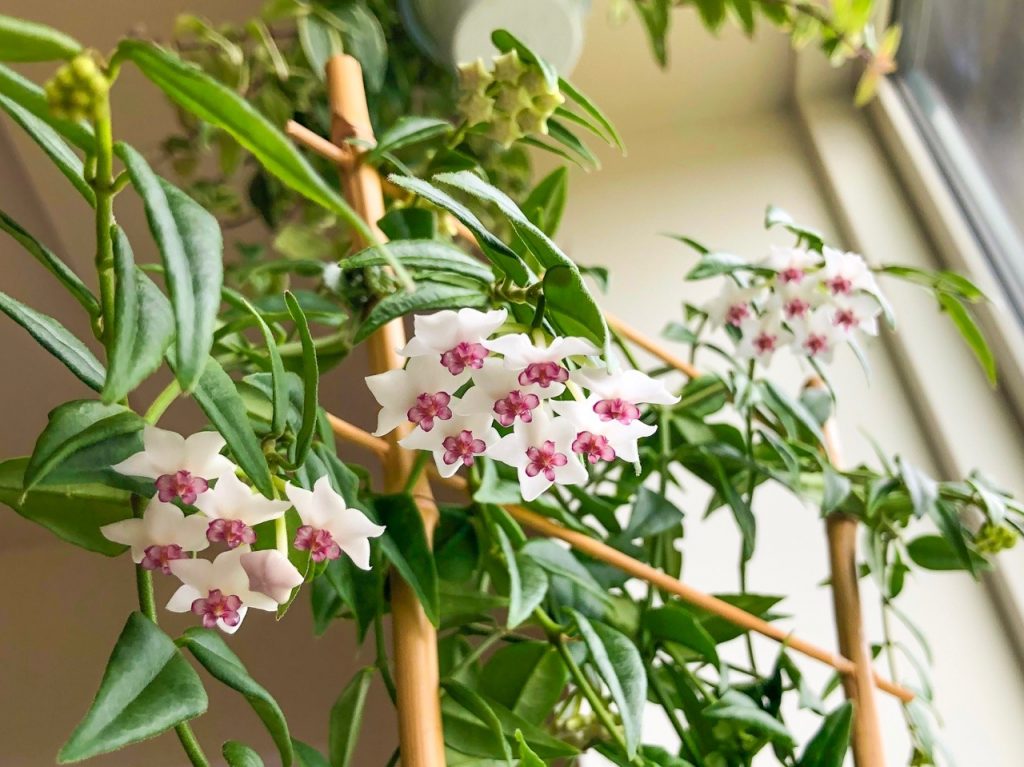
Hoya bella photo
general description
Hoya is also called Beautiful or Beautiful.
Botanical name - Hoya lanceolata ssp. bella. Is a subspecies Hoya lanceolata.
The tropical flower is suitable for growing in apartments, houses and offices in hanging planters. The root system is small, poorly branched. Stems are soft, thin, flexible, with thick internodes, falling, do not require support.
On the entire surface of the shoots, diamond-shaped leaves with pointed tips develop, 3-4 cm long, the upper side is emerald, the lower one is whitish.
Hoya blooms with small star-shaped flowers, consisting of white petals and a miniature dark pink crown in the center.
Each inflorescence contains 8-10 buds.
During the flowering phase, a pleasant sweetish aroma is thinned, which intensifies in the evening.
Varieties
The perennial hoya bella has several beautiful varieties that are successfully cultivated at home.
- Louis Buis. The full name is Hoya lanceolata ssp. bella cv. Luis Buis, or cv. Variegata (Variegata). The edges of the leaves are green, the center is bright green, and there is a whitish tint between them. There are also trade names for this form: Lida Buis or Mediopicta.
- Albomarginate. The full name is N. lanceolata ssp. bella cv. Albomarginata. This plant has light green leaves with white edges. The leaf plate is wide, narrowed closer to the tip. The underside of the leaves is whitish. Length - 7-8 cm, width 2-3 cm.
There is a misconception that the Minibella form is a form of Bella. But actually H.cv. Minibelle is a separate species, baptized by H. carnosa and H. shepherdii by Ed Hummel.
Purchase and adaptation
Almost all types of this indoor culture are readily available - you can purchase them at any flower shop. The choice should be approached responsibly, because the further health and decorativeness of an adult flower will depend on the quality of the seedling.
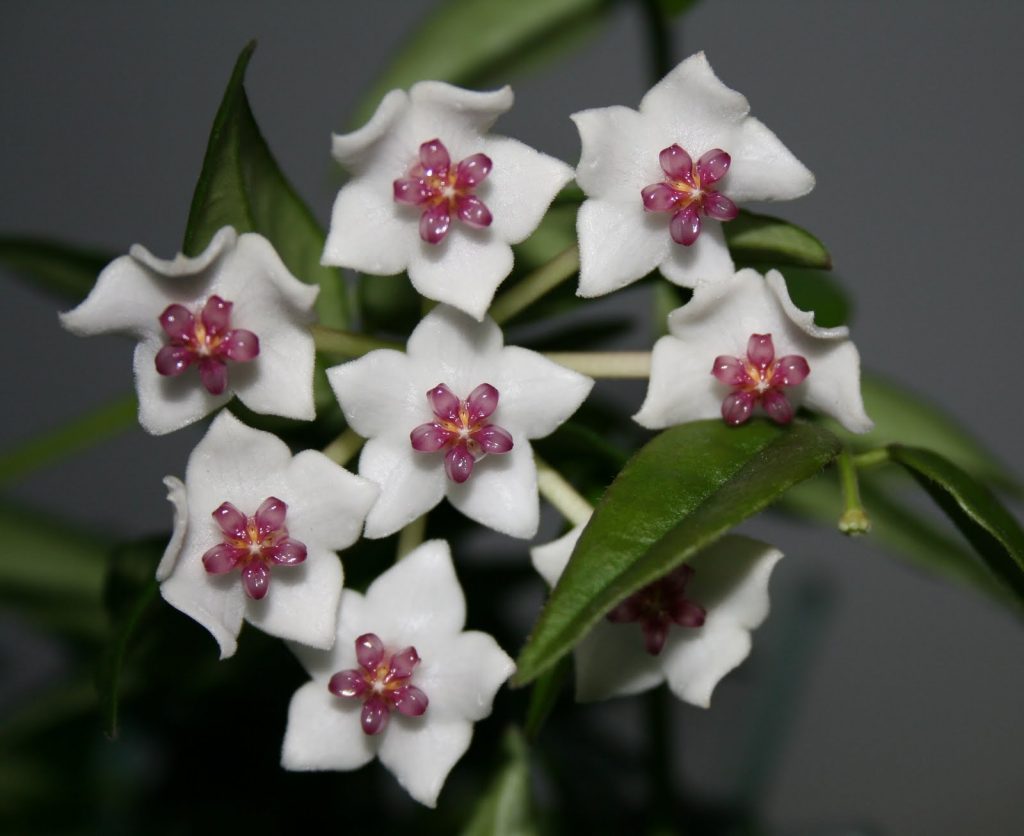
Hoya bella home care photo
The criteria for choosing a quality plant are as follows:
- the stems are flexible, monochromatic, without mechanical injury and damage from diseases, pests;
- leaves are juicy, rich in tone in accordance with the variety, do not contain yellow, black or brown spots, holes;
- the soil is slightly moist, without mold, acidification on the surface;
- through the drainage holes, you can determine the condition of the roots - they are dark brown, without rotting parts and plaque.
Shake off the crown - if the leaves do not crumble, then the plant is fresh and you can buy it.
The purchased flower must be quarantined for 2-3 weeks to make sure that it is not sick with anything.During this time, he adapts to room conditions.
Landing rules
It grows well in the light, so it is better to place it on a window where there is diffused lighting in the morning and evening - from the south or southwest side.
When grown on an eastern or northern windowsill, artificial lighting will be required, because with a lack of light, the leaves turn pale, flowering is poor, and the stems begin to rapidly stretch out.
The soil is suitable for loose, moisture and oxygen permeable. Usually use a store-bought substrate designed for growing orchids. You can also make a soil mixture with your own hands - mix turf, peat, sand and compost in a 2: 1: 1: 1 ratio.
The soil is sterilized before planting - spilled with boiling water or ignited in the oven for half an hour at a temperature of 100 ° C.
The necessary conditions
Hoya does not react well to heat and does not tolerate sudden temperature fluctuations, therefore, at the time of airing the room, it must be moved to a warm place.
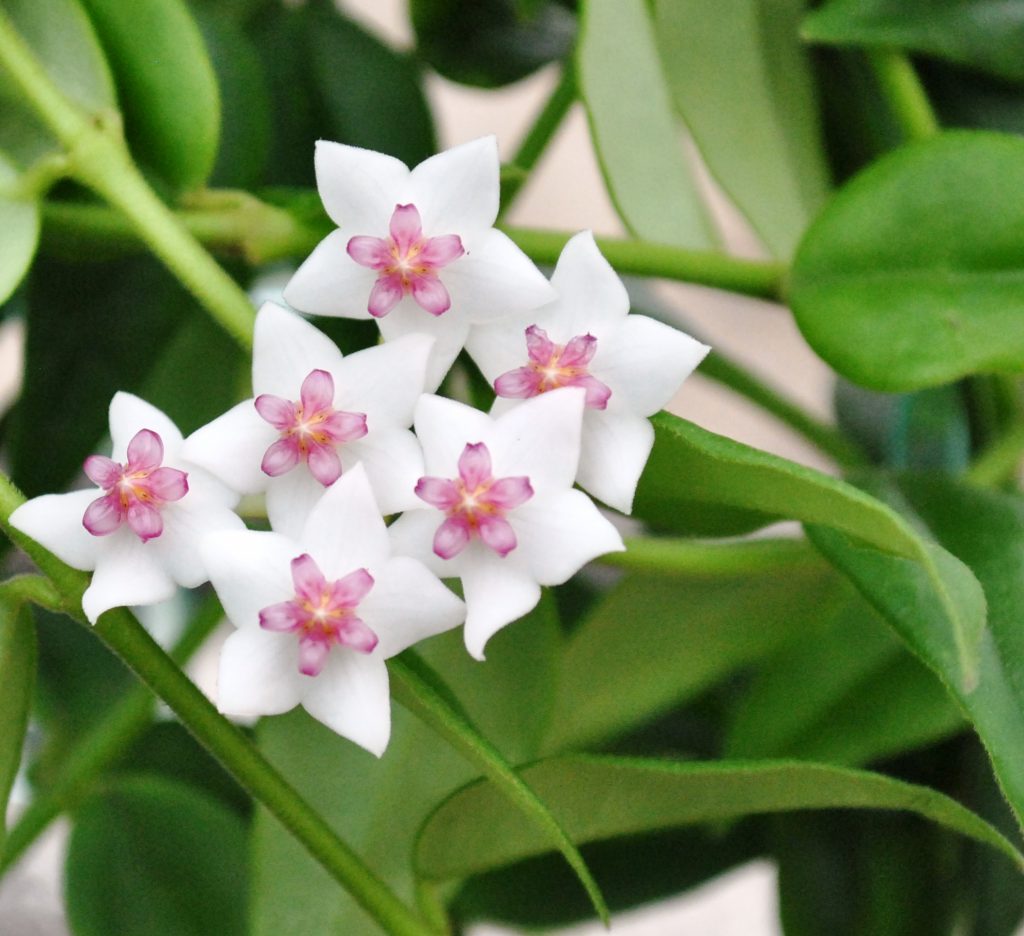
Hoya bella variegated
Temperature range:
- During the period of active growth and flowering - 22-25 ° С.
- In autumn and winter - 17-18 ° С. At this time of the year, the hoya enters a resting phase and prefers coolness.
In summer, the flower can be taken out to the balcony or loggia.
The plant prefers moderate air humidity - in the range of 60-70%. In spring and summer, the crown is irrigated every three days. In autumn and winter, sprinkling is necessary for hygiene reasons - once a month to wash away dust and prevent spider mites.
Reacts positively to occasional showers with warm water - every 30 days. Before carrying out the procedure, the soil is covered with a film.
The flower loves a lot of light - at least 10 hours. In spring and summer, this condition is provided by the sun's rays. In autumn and winter, they are illuminated with a fluorescent lamp. The device is placed at a distance of 0.5 m from the crown so that the leaves and stems are not burnt.
Care features
Watering
Throughout the entire period of growth and flowering, they are watered every three days. In the cold season - every two weeks.
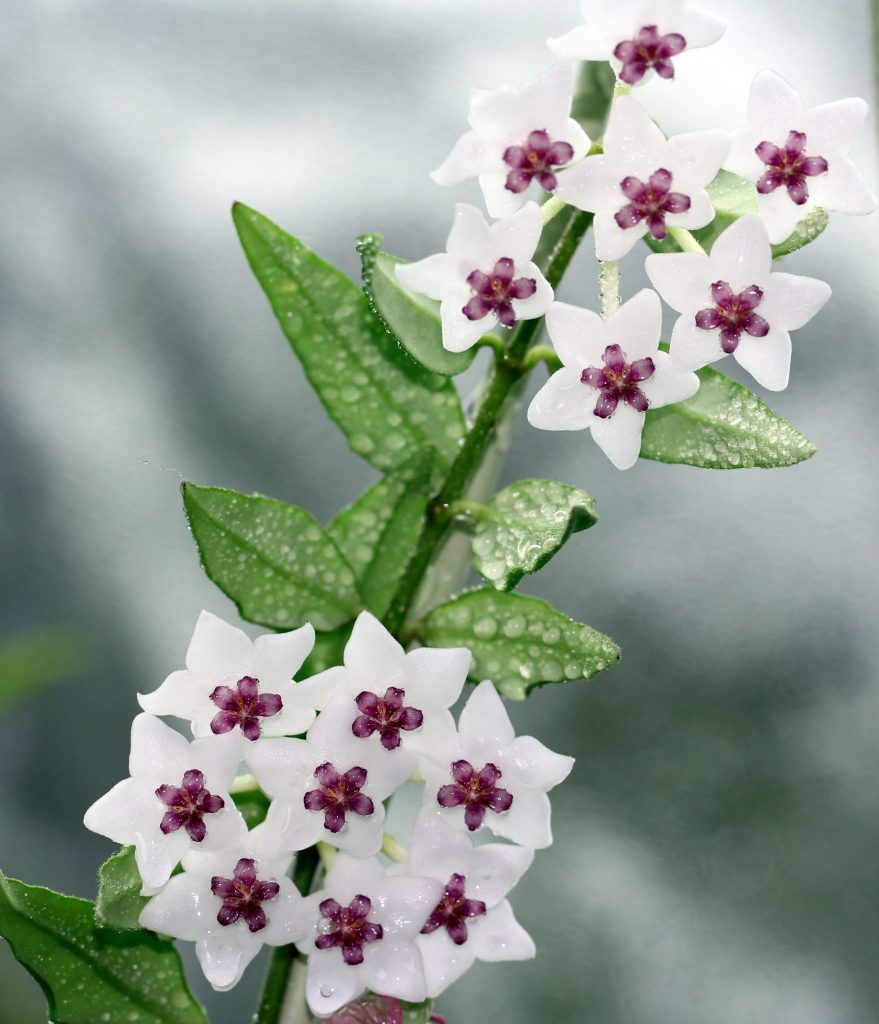
Hoya bella home care
The flower does not tolerate frequent moisture, because of this, its root rots.
The need for moisture can be determined by the condition of the soil - if it is dry to a depth of 3-4 cm, you can water it.
After this procedure, the soil is slightly loosened to maintain its aeration.
Top dressing
Nutrients are applied at the root in the summer. Complex mineral fertilizers are used for decorative flowering plants. Feeding frequency is every two weeks.
After feeding, abundant watering is carried out in order to speed up the process of assimilation of nutrients.
Pruning
After the inflorescences dry, do not cut off the flower arrows. Over time, fruits with seeds will appear on them, from which new seedlings can be grown.
Only dry, yellowed, rotten and broken off branches, as well as withered leaves, are cut off.
Transfer
After three weeks of home quarantine, they begin to transplant a purchased flower. It is moisturized to facilitate the extraction of roots.
Use vases made of plastic, ceramics with drainage holes at the bottom. The pot is taken a little larger than the old container. Fill ¼ of the volume with expanded clay, then with fertile soil, overload a lump with roots, add soil to the top, water it.
You also need to transplant a sick flower whose root system has rotted or has been damaged by insects or diseases. The moistened hoya is pulled out, the roots are washed from the ground, the non-viable parts are cut off, dipped in a fungicide solution, dried, planted in a new flowerpot with a sterile substrate.
Young flowers are transplanted regularly - every three years, adults - every five years.
Reproduction methods
There are several breeding methods that are successfully used by flower growers. Subject to all the rules of a particular technology, you can grow a strong plant, which in the future will delight you with colorful flowering.
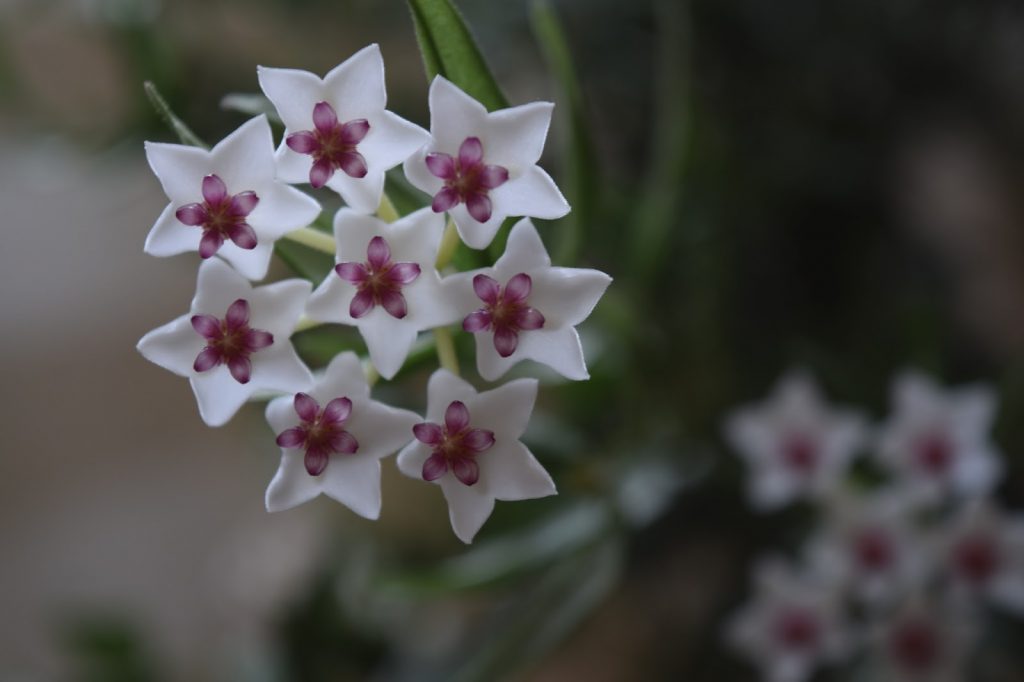
Hoya minibella
Seeds
Freshly harvested seeds are well dried, then sown on the surface of a loose mixture of coarse sand and peat. Planting depth - 1 cm. It is desirable to sow fresh seeds, because after a year they lose their germination.
Crops are irrigated, covered with foil, placed in a warm and well-lit place. A week later, when greens appear on the surface of the soil, the shelter is removed. Grow until they release one pair of leaves. Then they dive, grow for another month and plant them in pots in their permanent habitat.
Cuttings
The procedure is as follows:
- segments 15-20 cm long are cut from the top of the stems, in the lower part they are freed from foliage;
- immersed in water for a couple of hours with the addition of Kornevin or Epin;
- planted in a peat-sand mixture to a depth of 3 cm;
- moisten, cover with a transparent film.
The seedlings are aired every day, watered as the soil dries. At the stage of the appearance of the first leaves, the shelter is removed, grown for another month, then seated in separate flowerpots.
Sheet
The thickest and most juicy leaves are chosen, carefully cut off from the stem, the lower part is dipped in Kornevin's solution, then planted in a mixture of sand and peat. Sprinkle with warm water, cover with transparent glass.
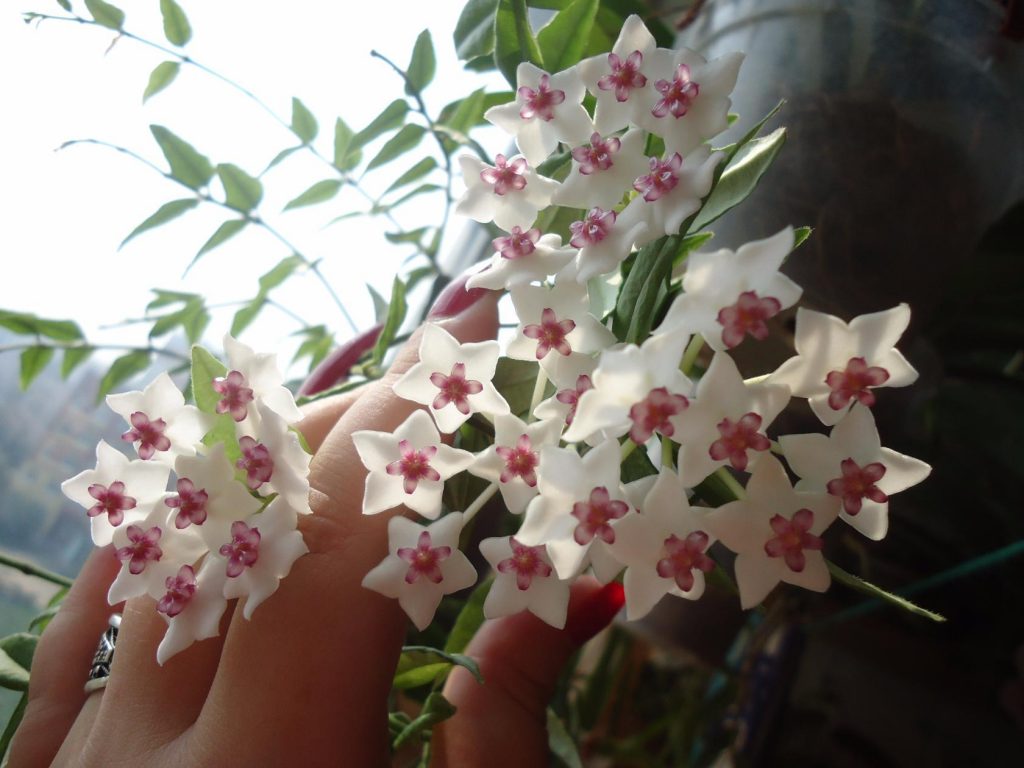
Hoya white
It can take about 2 weeks for the roots to germinate. During this time, the planting is regularly moistened and aired. They are planted separately 1-2 years after the appearance of the stem.
Diseases and pests
Throughout the entire growth period, this indoor flower can be sick or damaged by various harmful insects.
| Diseases and pests | Symptoms | Treatment methods | Prophylaxis |
| Powdery mildew | White bloom on leaves, stems. Over time, these places darken, begin to rot and wither away. | Remove all infected organs, treat the crown and soil with Ridomil Gold or Skor | Avoid overflow, reduce humidity, ensure stable heat |
| Root rot | The root rots, then the stems in the lower part become black, soft and slippery. | Remove from the pot, remove all rotten roots, rinse with fungicide, dry and transplant into a new container with sterile soil mixture. If the root is completely rotten, the flower is disposed of, several shoots are cut off for rooting. | Water only as the substrate dries up, use warm water for irrigation |
| Spider mite | It sucks the juices from the leaves, as a result of which they curl and dry out | Processing by Aktellik or Aktara | Increase the humidity and lower the temperature, spray the crown regularly |
| Shield | It feeds on the juice of shoots, foliage. The affected areas become covered with black spots, die off, crumble | Pruning of all infested areas, irrigation of the aboveground part and soil with Decis twice with an interval of 7 days | Use of disinfected soil for planting, transplanting, timely removal of non-viable shoots and leaves |
| Mealybug | Whitish bloom in the form of cotton wool on foliage, twigs. White worms eat away tissues, which leads to their yellowing and death. | Treatment of the crown with insecticides - Aktellik or Aktara | Provide good lighting, humidity and temperature. Remove yellowed and rotten stems, leaves in time |

